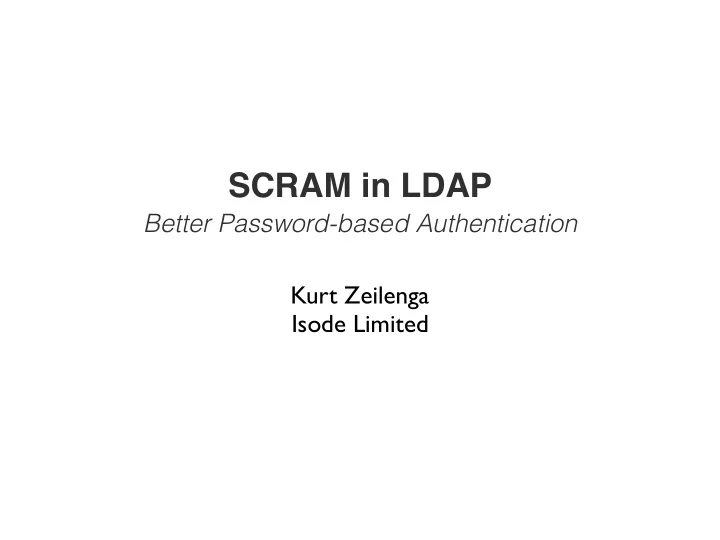

SCRAM in LDAP Better Password-based Authentication Kurt Zeilenga Isode Limited
What is SCRAM? • S alted C hallenge R esponse A uthentication M echanism • SCRAM-SHA-1-PLUS • An improved SASL mechanism for password authentication of the user. • Designed to mitigate threats of the modern Internet and Enterprise networks.
Why is it “better”? • Let’s review the history of password-based authentication in LDAP
Password authentication at the dawn of LDAP • LDAP Simple Bind with DN & Password (in clear) without any confidentiality protection and without authentication of the server. • Password stored in clear user entry • Octet wise comparison (ASCII assumed)
LDAPv2 over SSL • Data confidentiality protection needed to protect passwords during LDAP Simple Bind, as well as protect subsequent data exchange. • While SSL provided for complete client verification of server X.509 certificate, server verification not commonly performed in early years.
Enter SASL • RFC 2251 introduced SASL authentication to LDAP in 1997. • Password-based SASL mechanisms at this time included PLAIN and CRAM-MD5.
PLAIN • authcid + password • plus an authzid for identity assumption • Not much reason to use it (then or now) in LDAP , and generally not used in LDAP .
CRAM-MD5 • Primarily introduced to protect password during exchange. • Used heavily in email protocols. • Not generally used in LDAP as LDAP uses SSL to protect passwords. • LDAP deployers generally wanted to not only to protect passwords during exchange, but protect all LDAP data. Hence, CRAM- MD5 did not offer much value.
DIGEST -MD5 • Introduced to address weaknesses of CRAM-MD5 and to provide compatibility with HTTP Digest. • Provides for mutual authentication, but rarely properly implemented, rarely used. • Provides for data integrity/confidential protection, but wasn’t well implemented and is not widely deployed. • Provided for hashed password storage, but is a password equivalent.
Hashed Password Storage • Introduced by RFC 2307 (Experimental) • Compatible with use of Simple and PLAIN mechanisms and operating system login mechanism (e.g., crypt(3)) • Incompatible with DIGEST -MD5.
Enter RFC 2829/2930 • Detailed use of SASL and TLS in LDAP , including introduction of the Start TLS operation and the DIGEST -MD5 mandatory-to-implement requirement. • Strongly encouraged use of TLS to protect Simple Bind (server authentication, confidentiality protection).
LDAP Password Modify • RFC 3062 (Standard Track) • Introduced to eliminate need for client to know where the user entry is, or where the password is, or how it’s to be prepared for storage, etc. • Originally implemented in OpenLDAP , now broadly implemented (but not ubiquitous).
AuthPassword Introduced • RFC 3112 (Informational) • Intended to address abuse of userPassword to hold hashed user passwords • No known implementations
Enter RFC 4422/4510 • SASL and LDAPv3 Revised • Detailed handling of international user names and passwords • LDAP Mandatory-to-Implement authentication mechanism changed to StartTLS+Simple w/ DN & Password
Current Situation • Simple Bind with DN & Password over TLS (startTLS or ldaps://) is ubiquitous. • TLS certification checks generally implemented well but often not used or used improperly. • Use of hashed password storage is common (often required), commonly newer RFC 2307 schemes such as Salted SHA1 or even Salted SHA2.
So what’s the problem? • Users often send actual passwords without authenticating the server. • User has to trust server with its actual password. Server can impersonate user elsewhere. • Server has to assume client properly implements server authentication AND it’s properly used. Bad assumptions (especially the latter).
How does SCRAM address these problems? • Actual password not sent. Derived value sent is not reusable. • Mutual authentication: Server must produce a response that demonstrates it knowledge of the user credentials.
SCRAM Password Storage • Authentication information held in the server is not sufficient to impersonate the user, and is salted. • <insert example> • Simple Bind compatible (including same internationalization)
But we still have a problem... • Server has to assume client properly implements server authentication AND it’s properly used. Bad assumptions (especially the latter).
And this is serious problem... • Server not assured there is no man-in-middle.
Solution: SCRAM+ “Channel Bindings” to TLS • Proves to the client that the SCRAM server entity is also in control of the server TLS end-point. • Proves to the server that the SCRAM server entity is also in control of the client TLS end-point.
LDAP SASL Client Server TLS TCP
LDAP SASL Client Server TLS Relay T C P TCP
LDAP SASL Client Server TLS TLS Relay TCP TCP
LDAP LDAP SASL SASL Client Relay Server TLS TLS TCP TCP
LDAP SASL Client Server TLS TLS MITM TCP TCP
LDAP SASL Client Server TLS TCP
LDAP SASL Client Server TLS TLS X MITM TCP TCP
LDAP SASL Client Server TLS Relay T C P TCP
Details • SCRAM: RFC 5802 • TLS Channel Bindings: RFC xxxx • Further reading: http://www.isode.com/ whitepapers/scram.html
Questions
Recommend
More recommend